1967 Mini T – The Mini From Italy
02 October 2023
At first glance, this handsome Mini looks like a prime example of a Morris Mk.1 Traveller. Then you notice the left-hand-drive layout and the unfamiliar badging. It is, in fact, a 1967 Innocenti Mini T - one of the 437,234 Minis built in Milan.
The British Motor Corporation entered into an agreement with Innocenti, then best known for their motor scooters, to access the strongly protected Italian car market. A locally built product would circumvent import duties, and in July 1959, Innocenti signed a seven-year contract to build the Corporation’s products.

In October 1960, the Austin A40 Farina became the first Italian-built BMC vehicle, albeit six months behind schedule. Appropriately, Guiseppe Farina assisted with negotiations between Innocenti and the Corporation. The press reported plans to build 300 A40s per week and have at least one sales distributor in each of Italy’s main provinces by the end of the year.

The Ghia-bodied 950 Sprite and the ADO16 Morris IM3 were to follow, and Innocenti considered building the Mini as early as 1959. However, production did not commence until September 1965 for as Registro Storico Innocenti points out:
Only starting in 1965 did Innocenti’s production of a small car no longer risk compromising relations with Fiat. The end of protectionism, in fact, pushes Fiat to look at Innocenti no longer as a dangerous competitor but rather as a valid ally to stem the penetration of foreign car manufacturers into the domestic market. Innocenti can, therefore, produce the Mini without fear of retaliation from the Turin giant.

The Mini also seemed to have a different image from the Fiat 500 and 600, a town car for the fashionable set. By October 1966, ‘Mini Ts’ (Travellers) joined the range. BMC initially sent Minis from the UK in CKD – completely knocked down – kit form, but Innocenti subsequently made its own body panels. Early Mini Ts featured the timber framing of their British counterparts; an all-metal version became available in 1968. However, the T would continue to retain sliding windows until 1971, two years after the UK estate adopted sliding windows.

Innocenti extended its agreement with BMC, which became BLMC, following the merger with Leyland in 1968. The 6th May 1972 saw British Leyland acquire the Milan concern, which changed its name to Innocenti Leyland. Management in Longbridge planned to build 75,000 Minis annually, with exports to Belgium, France, The Netherlands, and Switzerland. One problem faced by Leyland in the UK was that many European customers preferred Innocenti Minis to their British counterparts because of their superior quality.

By 1974, the end of Leyland Innocenti was fast approaching. BL had banned the export of Italian Minis as they wished to provide more work for their domestic plants. The result was a vast overstock of Innocenti versions, and at that time, Italy’s economic downturn reduced the home market demand for fairly expensive small cars. Leyland closed the Innocenti factory on the 26th November 1975; minutes after the announcement, disgruntled former workers occupied the works.
As for this 1967 Mini T, it would look equally at home in the Tuscan countryside or in the driveway of a fashionable Rome villa. And always ready to be driven con brio.
